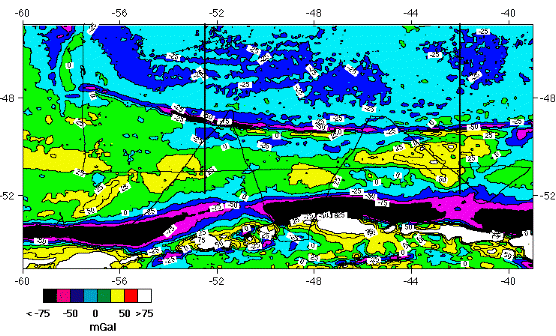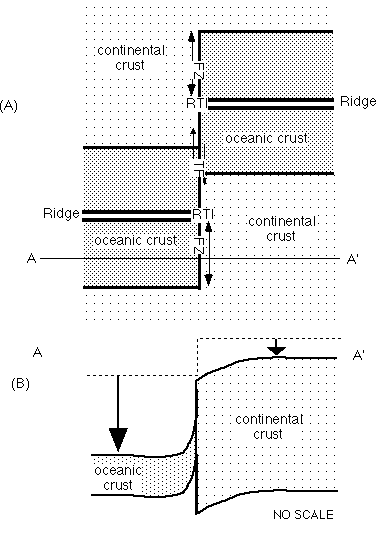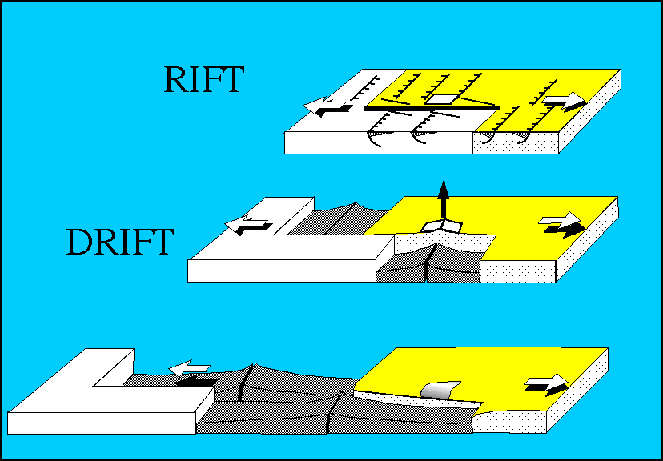-
1995 Fall AGU Abstract
-
Tectonic and stratigraphic response to flexure across
a continent-ocean transform boundary: Falkland/Malvinas Plateau, South
Atlantic.
-
Juan M. Lorenzo; Department of Geology and Geophysics, Louisiana State
Univ., Baton Rouge, LA 70803-4101; ph. 504-388-3353; fax 504-388-2302;
e-mail: juan@tellus.geol.lsu.edu, Paul Wessel, School of Ocean and Earth
Science and Technology, University of Hawaii at Manoa, Honolulu, HI 96822,
U.S.A.
We examine existent bathymetric, gravity and multichannel seismic
reflection data across the northern Falkland/Malvinas Plateau continent-ocean
transform boundary to determine the degree of mechanical coupling across
the fracture zone after ridge-transform intersection time. Previous geodynamic
models highlight the importance of continent-continent and ocean-continent
shearing along the active transform. However, in contrast to oceanic fracture
zone settings, the influence of coupled flexure on the stratigraphy and
tectonics of these margins remains undocumented.
The fossil transform basement rim of the Falkland Plateau comprises
a micro-continental block (Maurice Ewing Bank) in the east and a continental
marginal fracture ridge 50-to-100 km wide elsewhere. Strike-slip faults
and transpressional folds are the dominant structures, developed during
the active transform stage. The central Plateau (Falkland Basin) is underlain
by up to 7 km of Middle Jurassic-to-Recent sediments and partly floored
by overthickened oceanic crust. Depositional sequences can dip either south
from the marginal fracture ridge, or north from the Maurice Ewing Bank.
Gravimetric isostatic anomalies at two representative transects across
the margin (42deg. W and 52.5deg.W) indicate that vertical shear stresses
are consistent with differential thermal subsidence models in a locked
fault regime. By forward modeling free-air gravity anomalies we interpret
that the marginal fracture ridge is coupled mechanically to oceanic elastic
lithosphere both north (Early-Middle Cretaceous Argentine Basin) and south
(Middle Jurassic Falkland Basin). Flexural subsidence may offset effects
of thermal uplift induced by heating from the oceanic lithosphere.

Fig. 2 Satellite-derived free-air gravity anomaly map (Sandwell et al.
1995) over the Falkland Plateau study area; bathymetry contours are superposed.
Study area is located west of the South America. A negative gravity anomaly
lineament in the Argentine Basin, running along the 6000 m isobath and
parallel to the Falkland Escarpment corresponds to a linear negative magnetic
anomaly modeled by Rabinowitz and LaBrecque (1979) as an oceanic fracture
zoneBy extension, parallel lineations further north may also overlie fracture
zones. Two thick black lines locate the extent of north-south sections
used for modeling and seen in other Figures in paper (5A, 5E).

Fig. 1 (A) Schematic plan view of continent-ocean active and passive
transform boundaries. RTI: ridge-transform intersection, FZ: fracture zone,
TF: transform fault. (B) Profile through the fracture zone, landward of
the RTI shows effect of assuming a mechanical model where lithosphere on
either side of fracture zone subsides at different rates but remains mechanically
coupled. Only crustal blocks used for gravity modeling are shown. Total
amount of subsidence implied by the length of the arrows is greater on
the oceanic side. A dashed line marks the initial top of the crust at RTI
time. Predicted bathymetry has a thermally younger (oceanic) side that
bows up whereas the thermally older (continental) side bows down.
Published versions of figures above are available in the following
issue of Geo-Marine Letters in the article by Lorenzo and Wessel
An International Journal of Marine Geology
Sheared continent-ocean margins
-
Juan M. Lorenzo, Special Editor

Figure Idealized two-stage development of continent-ocean fracture
zones across continental margins during rifting and drifting. During early
drifting, the young oceanic block slides against the older continental
block possibly inducing thermal uplift. After the passing of a ridge when
the transform becomes inactive, mechanical coupling across the fracture
zone is possible. The faster subsiding oceanic lithosphere drags down the
continental block. Vertical black arrow implies thermally induced uplift
on continental block. With subsequent cooling and mechanical coupling to
faster subsiding oceanic block, the continental block may bow down on approaching
the fracture zone.
In journal order, manuscripts froma Special publication
of Geo- Marine Letters on Sheared Continent-Ocean Margins Vol 17, 1997
1. J.M. Lorenzo Sheared continent-ocean margins: An overview.
p. 1-3
2. J. Mascle, G.P. Lohmann et al.. Development of a passive transform
margin: Cote d'Ivoire-Ghana transform margin; ODP Leg 159 preliminary results.
p. 4-11
3. R.E. Edwards, R.B. Whitmarsh, R.A. Scrutton, Geophysical features
and geological development of the Ghana transform continental margin. p.
12-20
4. S.A. Gadd and R.A. Scrutton. An integrated thermomechanical
model for transform continental margin evolution. p. 21-30
5. F. Sage, B. Pontoise, J. Mascle and Ch. Basile Structure of
oceanic crust adjacent to a transform margin segment: The Côte d'Ivoire-Ghana
transform margin. p. 31-39
6. F. Sage, B. Pontoise, J. Mascle and Ch. Basile, L. Arnould
Crustal structure and ocean-continent transition at the Cote d'Ivoire-Ghana
marginal ridge. p. 40-48.
7. J. Benkhelil, J. Mascle, M. Guiraud, Ch. Basile, and the Equanaute
scientific team Submersible observations of Cretaceous deformation along
the Cote d'Ivoire-Ghana Transform margin. p. 49-54.
8. J.-P Bouillin, G. Poupeau, E. Labrin, Ch. Basile, N. Sabil,
J. Mascle, G. Mascle, F. Gillot, L. Riou. Fission track study of the marginal
ridge of the Ivory Coast-Ghana transform margin. p.55-61
9. G. Lamarche, C. Basile, J. Mascle & F. Sage. The Cote
d'Ivoire-Ghana transform margin: sedimentary and tectonic structure from
MCS data. p. 62-69.
10. M. Guiraud, J. Benkhelil, J. Mascle, C. Basile, G. Mascle,
J.P. Bouillin and M. Cousin: Syn-rift to syn-transform deformation: Evidence
from deep sea dives along the Cote-d'Ivoire-Ghana transform margin. p.
70-78.
11. M. Guiraud, J. Mascle, J. Berkhelil, C. Basile, G. Mascle
and M. Durand: Early Cretaceous deltaic sedimentary environment of the
Cote-d'Ivoire-Ghana transform margin as deduced from deep dive data. p.
79-86.
12. I.D. Reid and H.R. Jackson Transform margins of eastern Canada.
p. 87-93.
13. J. Prims, K.P. Furlong, K.M.M. Rohr, R. Govers. Lithospheric
structure along the Queen Charlotte margin in western Canada: Constraints
from flexural modeling. p. 94-99.
14. E. Vagnes: Uplift at Thermo-mechanically coupled ocean-continent
transforms; modelled at the Senja Fracture Zone, southwestern Barents Sea.
p. 100-109
15. J.M. Lorenzo and P. Wessel Flexure across a continent-ocean
fracture zone: The northern Falkland/Malvinas Plateau, South Atlantic.
p. 101-110.